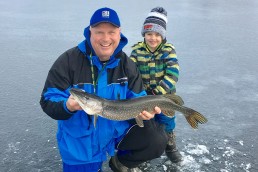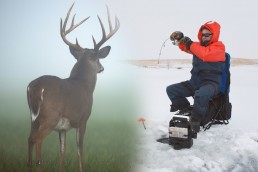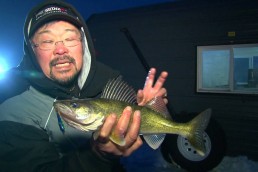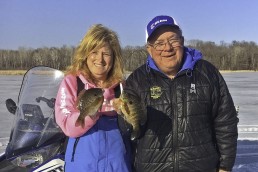First-ice Pike
SHARE THIS POST
Set tip-ups as soon as the ice is safe for some fast pike action
“That didn’t take long,” my friend Tony said as he pointed out a flag up on one of our tip-ups. We were still setting the last one in our spread of eight Frabill Thermal round tip-ups when we had to stop to head to a flag. My son, Parker, hopped on the ATV with my friend Tony Happ and I to head about a hundred yards down the weedline to the triggered tip-up. My dad, Nate, stayed behind to finish setting the last Frabill. The spool was still spinning as we got to the tip-up. When it slowed, Tony lifted the Frabill Thermal out of the hole and set the hook. The pike on the small farm lake we were fishing are fat, strong, and active early in the ice season. It took Tony a while to land the 32-inch northern. After a couple pictures, Tony slid the fish back into the hole and then lamented that the bucket with our sucker minnows was back where we had come from.
A whistle and a point from my Dad got us back on the ATV to head to another flag up. “We’ll get the bucket and bait up both rigs after we catch this fish,” I mused, and we were off to the flag that was up. Parker, age six, was experiencing his first early ice pike tip-up bite. The smile on his face as we pulled up to our second flag up of the day said it all. It was going to be a great day.
Bagging pike in Minnesota
Early ice pike fishing can be just this fast when conditions come together just right. Warm, windy, and wet fall weather in Minn., in 2017, caused ice to form slowly on our lakes—especially large ones. That is why we were on the small, weedy, farm lake in central Minnesota. Lakes of this type will ice up best, earliest, due to being shallower and less windswept than larger lakes. The fertile, weedy lake we had chosen has a good sunfish and perch population, which leads to a healthy northern pike population. The weeds were still thick and healthy under the eight inches of ice, so sunfish and perch were still in and around those weeds. That had the pike cruising the weed edge, in about 8 to 10 feet of water. This is a typical location to target during early ice. There is still plenty of dissolved oxygen shallow, by the weeds, to keep fish present. The presence of forage fish has the predators, like pike, on the feed.
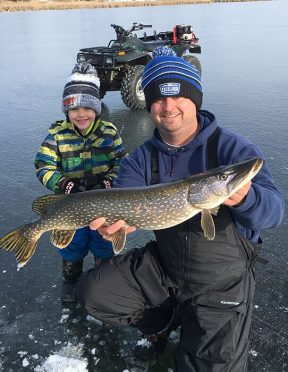
While the small lake we were on has a healthy population of pike—including many large ones up to 40 inches—generally, larger bodies of water will produce the larger pike. Once the ice is safe on larger lakes in our area, we head to them. On these larger lakes, we still target shallow weed edges. We look for these at the opening to shallow, weedy bays, on shallow reefs, and on shallow shoreline points. On these larger lakes, weedy structures that are close to deep-lake basin areas are often the best. As the weeds begin to die off when the ice thickens and gets covered with snow, the dissolved oxygen levels drop in these shallow areas. This moves the panfish and perch—and the pike—to the deeper basin areas where the water is warmer and more oxygen-rich.
This early ice pike bite gets going right away. As soon as it is safe to get out on the ice, you should have good action. There are countless small, fertile, weedy lakes with populations of northern pike scattered across the Midwest. You will need to do your homework to find out which of this type of lake in your area supports a healthy pike population, and which has public access.
Are you enjoying this post?
You can be among the first to get the latest info on where to go, what to use and how to use it!
Mind where you step
These lakes will be the first with safe ice to walk on, and later to drive ATVs on. Be sure to check ice thickness by drilling holes regularly on your walk out the first time you venture out on a lake early in the ice season. Just because you see another person or two on the lake doesn’t mean it is safe. I have turned back to shore several times after my first couple test holes showed three inches of ice on a lake that had people out fishing on it. No pike is worth going for a December swim! I carry ice picks hung around my neck and often wear a life vest under my parka when out on a lake for the first time during the early ice period. Plus, I don’t go out alone. As the ice gets thick enough (six to eight inches) for ATVs on these small lakes, the ice on the larger lakes in your area might be ready to test for walking out. Usually, by the time the ice is thick enough to drive a truck out on, this shallow weed edge pike bite has slowed or stopped.
While it is certainly possible to catch pike sitting over a hole and jigging for them, this time of year, I like to set out a spread of tip-ups. We set eight tip-ups for the four of us on the day described in the opening. Five of the tip-ups were right at the weed edge and three of them out from 10 to 25 yards off the weed edge. On that day, the baits close to the weed edge were catching the fish. So, we wound up moving the other baits in closer.
We were using small and medium sucker minnows hooked behind the dorsal fin with a single 4/0 Aberdeen hook. The hook was tied to an 18-inch leader of 30-pound-test Berkley FireLine Crystal that was attached to the tip-up braid by a snap swivel. The heavy FireLine is much less visible underwater than the tip-up braid, but is still abrasion-resistant enough to fend off the pikes’ teeth.
We were using Frabill Thermal round tip-ups. These tip-ups are durable, have a built-in storage box for split-shot, extra hooks, and markers for marking your depth. They also are insulated and cover the entire hole, so you don’t get ice forming over your hole in below-freezing temps. We had the sucker minnows suspended one to two feet off of the bottom.
For jigging for early ice northern pike, I like to use a medium to medium-heavy power rod, 28 to 34 inches long, with 14 to 20-pound Berkley FireLine Crystal on a good spinning reel. I keep the baits simple this time of year: a large jigging spoon like a VMC Rattle Spoon tipped with a large minnow head or a 4-inch Berkley PowerBait Minnow, or a 3-inch Jigging Rap. Often, I will combine some people vertical jigging with some tip-ups out to see what the fish prefer.
A lot of Midwest anglers find themselves anxiously awaiting the ice to form and thicken during late November and into December. This early ice pike bite is a good way to get out of the house and start ice fishing instead of just dreaming about it inside. Do your homework to find lakes with pike and to check the ice thickness. Be safe and use common sense. You can have a blast catching some nice pike and lots of them. This early ice period is often the best ice-fishing action of the season and you usually aren’t fighting crowds and noise out on the lake like you will later when the ice is thick enough for trucks and wheel houses. On the day described in the opener, the four of us were the only people on the lake. We caught seventeen pike in about four hours that day—most of them between 28 and 35 inches. For many ice fishermen, the sight of a tip-up flag up and the line spool spinning is something we can’t get enough of. Give this early ice pattern a try—you won’t be disappointed.
MWO
SHARE THIS POST
Did you enjoy this post?
You can be among the first to get the latest info on where to go, what to use and how to use it!
Troy Smutka
Troy Smutka is a central Minnesota fishing guide (greatdayonthewater.com) and a walleye tournament angler. He is also a member of the Lund Boats, Mercury Outboards and Johnson Outdoors Pro Teams, and hosts and produces Fishing and Hunting the North Country on YouTube.
